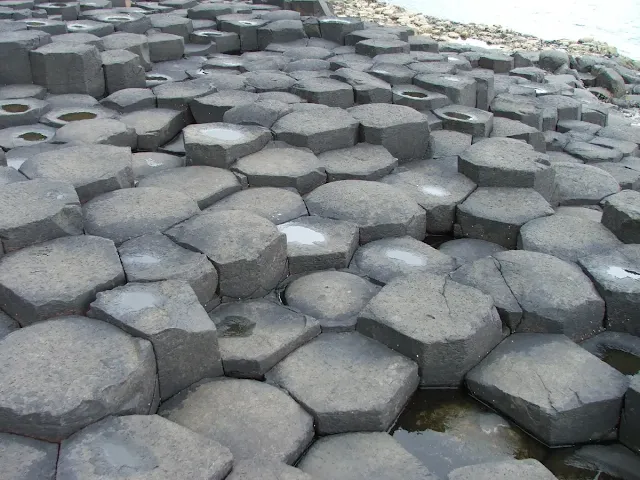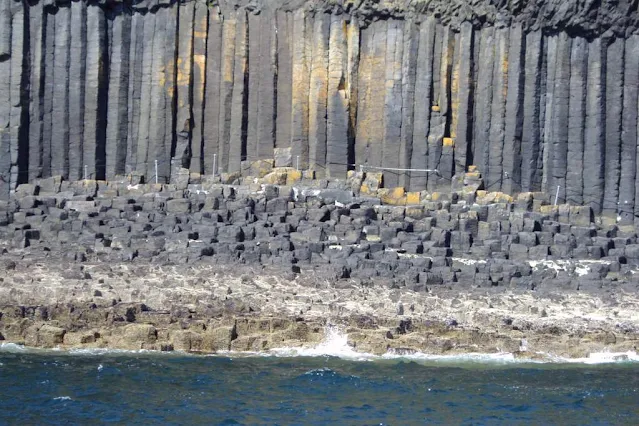How These Rocks Got Their Hexagonal Shape
Columnar basalt, with its mesmerizing arrays of tightly packed, polygonal columns, is a geological marvel. These columns, often hexagonal in shape, can tower meters high and create landscapes of otherworldly beauty, like the Giant's Causeway in Ireland or Devils Tower in Wyoming. But how do these seemingly perfectly geometric shapes form in nature?
What is columnar basalt
Columnar basalt is a type of igneous rock formed from the cooling and solidification of lava flows. As the lava cools, it contracts and cracks, often forming closely packed polygonal columns, typically hexagonal. These columns can be massive, reaching heights of tens of meters.
How are hexagonal columns formed in basalt
Columnar basalt, characterized by its striking array of closely packed, polygonal columns, arises from the solidification and cooling of lava flows. This phenomenon, governed by the principles of thermodynamics and material science, can be explained through the following key mechanisms:
1. Cooling and Contraction: As lava erupts and flows, it gradually loses heat to the surrounding environment, causing its temperature to decrease. This cooling triggers a reduction in volume, or contraction, within the lava due to thermal expansion.
2. Stress Distribution and Crack Initiation: The contraction process induces internal stresses within the cooling lava. These stresses are not uniformly distributed but rather concentrate at specific locations, typically along planes perpendicular to the cooling surfaces (top, bottom, and sides of the flow). When the stress exceeds the tensile strength of the solidifying lava, cracks begin to form along these planes.
3. Crack Propagation and Hexagonal Formation: The initial cracks propagate inwards from the cooling surfaces, guided by the stress distribution within the lava. As they propagate, they tend to branch out and intersect at angles of approximately 120 degrees due to the minimization of stress concentration at these angles. This pattern of intersecting cracks ultimately results in the formation of polygonal columns, with hexagons being the most common due to their optimal packing efficiency.
 |
| Columnar basalt Giant’s Causeway located in County Antrim in Northern Ireland |
Factors Affecting Column Size and Shape
Thickness of the Lava Flow: Thicker flows generally exhibit larger columns due to the greater distance over which the cracks propagate.
Cooling Rate: Slower cooling allows for more organized crack propagation, leading to well-defined and often more intricate columnar structures.
Lava Composition: The chemical composition of the lava can influence its thermal properties and mechanical strength, impacting the size and shape of the resulting columns.
Therefore, the formation of columnar basalt is a direct consequence of the cooling process and the associated contraction-induced stresses within the solidifying lava. The resulting hexagonal columns represent a natural optimization of crack propagation and stress minimization, showcasing the intricate interplay of physical principles in shaping geological landscapes.
Examples of Columnar Basalt Formations
1. Giant's Causeway, Northern Ireland: This UNESCO World Heritage Site features over 40,000 tightly packed basalt columns, rising up to 12 meters in height. The columns, primarily hexagonal but also including pentagonal and heptagonal shapes, were formed from a Paleocene-era lava flow approximately 50-60 million years ago.
2. Devils Postpile National Monument, California, USA: Located within the Sierra Nevada mountain range, this iconic site showcases an array of hexagonal basalt columns formed approximately 1 million years ago. The columns, reaching up to 60 meters in height, were formed from a lava flow that solidified and contracted, resulting in the characteristic fracturing pattern.
3. Fingal's Cave, Staffa Island, Scotland: This sea cave, formed by a Miocene-era lava flow, boasts a dramatic display of hexagonal basalt columns, visible only from the sea. The columns, reaching up to 20 meters in height, form a natural colonnade that has inspired artists and writers for centuries.
4. Svartifoss, Iceland: This waterfall, nestled within Skaftafell National Park, cascades over a dramatic wall of hexagonal basalt columns formed from a lava flow around 9,000 years ago. The columns, ranging in height from 12 to 40 meters, exhibit a stunning interplay of light and shadow, creating a mesmerizing natural spectacle.
5. Devils Tower, Wyoming, USA: This 264-meter-tall monolith, composed entirely of columnar basalt, stands out dramatically from the surrounding landscape. The columns, formed from a volcanic intrusion approximately 50 million years ago, range in size and shape, adding to the unique character of this iconic landmark.
 |
| Columnar Basalt |
Are there any other shapes besides hexagons
While hexagons are the most common shape found in columnar basalt, other shapes, such as pentagons and heptagons, can also occur. This is because the stress distribution within the cooling lava is not always perfectly uniform, leading to slight variations in the angle between cracks.
Read also: The Largest Insect Ever Existed Was a Giant "Dragonfly"
Scientists Solve the Mystery of How the Columns of Devils Tower Formed

